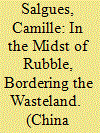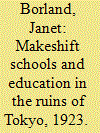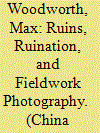|
|
|
Sort Order |
|
|
|
Items / Page
|
|
|
|
|
|
|
| Srl | Item |
| 1 |
ID:
182941


|
|
|
|
|
| Summary/Abstract |
Drawing from two ethnographic studies of children, one in a former industrial neighbourhood in the process of demolition in Shanghai, and the other in a rural town in Guangdong, this article explores the relationships children form with the landscape of ruins as they wander about with the aim of identifying the opportunities these offer in terms of games, freedom, and sharing, etc. The article analyses two different dynamics in the types of ruins and the experiences associated with them: concentration and dispersion. The structural geography and qualitative demography that emerge from this are barely mentioned in Chinese public debate, in its categories (children of “migrant workers” or “left-behind” children), its problems, and its very negative representations, but whilst they underline the unequal divisions in society, they also reveal a richness of experience that is far from being necessarily unhappy.
|
|
|
|
|
|
|
|
|
|
|
|
|
|
|
|
| 2 |
ID:
088121


|
|
|
|
|
| Publication |
2009.
|
| Summary/Abstract |
A range of issues confronted government officials in the aftermath of the Great Kant? Earthquake, but almost immediately they began efforts to resume education. This article examines how educators overcame numerous challenges in order to recommence primary school education and return children to makeshift classrooms in the ruins of Tokyo. Education was viewed as an important means to help restore a sense of normality in the lives of displaced school children at this time of extraordinary upheaval. Educators were concerned not only with the material reconstruction and recovery of schools, but also the physical and mental recovery of children.
|
|
|
|
|
|
|
|
|
|
|
|
|
|
|
|
| 3 |
ID:
182939


|
|
|
|
|
| Summary/Abstract |
This article offers a self-reflexive critique of ruins as method by examining side-by-side the production, circulation, and meaning-making processes around the ruin photography of ghost cities in China and the author’s own production of a fieldwork archive of the same photographed spaces. The ruin is commonly understood in recent scholarship to be a deeply ideological artefact with meanings contingent on class-inflected practices of ruin appreciation. In a similar vein, photography of urban ruins has been heavily criticised for allegedly aestheticising social ruin and economic decline. The critique of ruin photography as a practice of ideological claim-making or as a form of critical engagement merits scrutiny in light of this issue’s field research practices looking at ruins in China. More specifically, photography is a standard part of fieldwork, including the author’s. The aim of this article, then, is to ask how and why photographs of urban ruins in China differ across image-making practices? How are fieldwork photos of ruins, the kinds of photos that generate a data archive and are used in scholarly publications, resonant with other ideological claim-making purposes of ruin photography? How might we account for the political valences of image aesthetics when photographs are a vital part of scholarly efforts?
|
|
|
|
|
|
|
|
|
|
|
|
|
|
|
|
| 4 |
ID:
182940


|
|
|
|
|
| Summary/Abstract |
Ruins and rubble have become a ubiquitous feature of the urbanising Chinese landscape. They have also become key motifs in Chinese visual culture, and artists have used the ruin image to critically comment on post-reform urban development. This article, however, seeks to bring an overlooked dimension of ruin representation to light: the creative culture of China's “urban explorers,” who infiltrate obsolete architecture for their own recreational purposes. It shows how the derelict spaces portrayed by the explorers’ visual and textual accounts have a ludic potency of their own, with the urban ruin depicted as a site of embodied and aesthetic pleasure. The article ends by discussing the example of urban explorer Zhao Yang and his Cooling Plan photography project, which frames the ruin as a creative retreat from the pressures of the lived city.
|
|
|
|
|
|
|
|
|
|
|
|
|
|
|
|
|
|
|
|
|